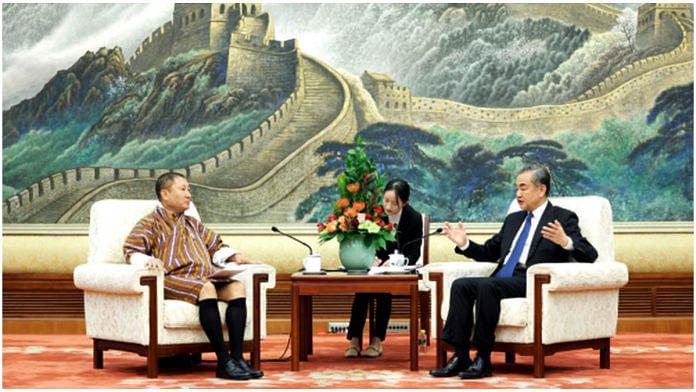New Delhi: Bhutan and China have taken another step towards resolving their border dispute — a move that marks an upswing in Thimphu’s ties with Beijing and may impact India’s strategic interests.
The two countries have signed a cooperation agreement on the responsibilities and functions of the Joint Technical Team (JTT) on the delimitation and demarcation of the border. In a joint statement Tuesday, the two sides commended the work done by an expert group in this regard.
Bhutanese foreign minister Tandi Dorji, who was in Beijing for the talks Monday and Tuesday, also met his Chinese counterpart Wang Yi, as well as Chinese Vice President Han Zheng.
Dorji and Han agreed to “accelerate” the boundary demarcation process and establish diplomatic ties between the two countries, as reported by Xinhua. Bhutan — whose foreign policy has largely been in sync with that of India until now — does not maintain official diplomatic ties with China, with which it has had tense relations.
“China always respects Bhutan’s independence, sovereignty and territorial integrity, and is willing to strengthen exchanges at all levels and in all fields, expand practical cooperation on the economy, trade, culture and tourism, and accelerate the boundary demarcation process and the establishment of diplomatic relations with Bhutan to bring more benefits to the two countries and the two peoples,” Han said, as reported by Xinhua.
Dorji was quoted as saying that the Bhutanese government abides “firmly by the One China principle” and attaches great importance to the development of relations with China.
As reported by ThePrint earlier, China claims around 764 sq km of land in northwestern and central Bhutan, in a dispute that dates to the Chinese occupation of Tibet in the 1950s.
The joint technical committee was established in August of this year during the 13th Expert Group meeting (EGM) held between 21 and 24 August.
The joint statement issued Tuesday said: “The two sides held in-depth discussions on the boundary negotiations and noted the progress made through a series of Expert Group Meetings since the 24th Round of Boundary Talks in 2016. The two leaders of the delegations commended the Expert Group for the work done and agreed to build on the positive momentum.”
“The two sides agreed to continue working together to simultaneously push forward the implementation of all the steps of the Three-Step Roadmap.”
China ties ‘serve fundamental interests of Bhutan’
During his meeting with Dorji Monday, Chinese foreign minister Wang said that concluding the boundary dispute and establishing diplomatic relations with Beijing would serve the “long-term fundamental interests” of Thimphu.
“China is ready to work with Bhutan in the same direction, seize the historic opportunity, complete this important process as soon as possible, and fix and develop China-Bhutan friendly relations in legal form,” Wang is reported to have said according to a readout of the meeting published by China’s Ministry of Foreign Affairs.
Dorji reportedly said: “Bhutan firmly abides by the One China principle and stands ready to work with China for an early settlement of the boundary issue and advance the political process of establishing diplomatic relations.”
“Bhutan highly appreciates and supports the three major global initiatives proposed by President Xi Jinping, which have delivered benefits to all parties, especially its neighbors, including Bhutan,” Dorji added, referring to Bhutan’s support for the Global Development Initiative, Global Security Initiative and the Global Civilisational Initiative announced by Chinese President Xi Jinping in the past two years.
India’s concerns and Doklam
As reported by ThePrint earlier, the boundary dispute began when China occupied Tibet in 1950 and refused to recognise the “dividing” line between Tibet and Bhutan. China seized control over eight Bhutanese enclaves in Tibet in 1959.
Since then, negotiations between Thimphu and Beijing have focussed only on three areas of contention — the Jakarlung and Pasamlung areas in north Bhutan, as well as the more well-known Doklam area in west Bhutan.
In 2020, Beijing asserted ownership of the Sakteng Wildlife Sanctuary, which is located in eastern Bhutan and borders Arunachal Pradesh.
For India, the point of contention is Doklam. India considers Doklam a part of Bhutan, but Beijing considers it an extension of the Chumbi Valley – the wedge between Sikkim and Bhutan. The plateau has an area of approximately 89 sq km, with a width of less than 10 km.
Doklam overlooks the strategically important Siliguri corridor — the gateway to India’s Northeast. It also links India with Nepal, Tibet, Bhutan and Bangladesh.
China’s attempts to build a road in Doklam in 2017 led to a stand-off between Beijing and New Delhi that continued for over two months. It ended with China agreeing not to construct the road. India was concerned about the possibility that China could take over Doklam during the talks, as reported by ThePrint earlier.
(Edited by Rohan Manoj)
Also read: Jolted by Lanka, Pakistan, Bangladesh, Bhutan ‘taking steps to strengthen economy’, says FM Dorji



